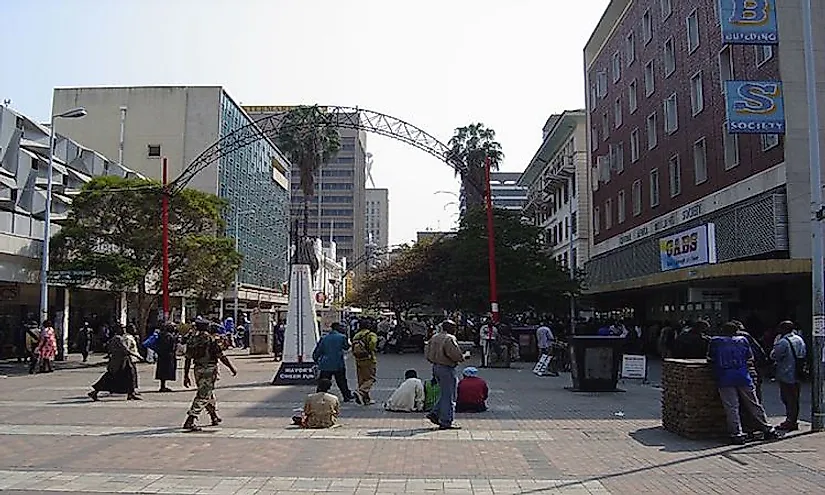Biggest Cities In Zimbabwe

Harare in Zimbabwe’s northern Highveld region is the country’s capital and largest city. Located in southern Africa, Zimbabwe borders Zambia, Botswana, South Africa and Mozambique. The country covers a total area of 390,580 square miles and has a population estimated at 15.6 million inhabitants.
Biggest Cities In Zimbabwe
Harare
The capital, Harare boasts 1,606,000 inhabitants. Historically, Harare was established as a fort named Salisbury by the British in 1890, who were keen to seize Mashonaland. Salisbury became an important administrative and economic center for the British Southern Rhodesia administrative region. Granted city status in 1935, the city was renamed Harare in 1982, two years after the country gained independence. Harare has and still is the economic backbone of Zimbabwe. Before independence, British settlers had engaged in gold mining and agriculture. Agriculture, gold mining are still the core economic activities in Harare, as well as numerous industries. The dominant ethnic group in Harare is the Shona, followed by the Ndebele and a small population of white residents. The government of Zimbabwe has taken measures to curb slum proliferation. In April 2005, under a project known as Operation Restore Order, destruction of slums and roadside businesses was carried out by the government. In 2006, Operation Chikerema was carried out involving the construction of concrete houses which have been criticized for lacking necessary amenities such as plumbing. Most of Harare’s residents live in townships around the city. There are also wealthy suburbs around the city, complete with amenities such as malls and golf clubs. Being a cultural center, Harare is dotted with historical and cultural sites including the National Gallery of Zimbabwe, National Museum, Queen Victoria Library and National Archives. The National Botanic Garden in the city is home to abundant plant species while the Mukuvisi Woodlands Nature Reserve is home to some of the country’s iconic wildlife. Harare has its fair share of traffic and human congestion. An emerging trend in the city is the construction of high-rise buildings.
Bulawayo
Bulawayo City, situated in Matabeleland, is home to 1,200,337 residents. Bulawayo was established as the royal capital of King Lobengula of the Ndebele Empire. The name Bulawayo translates to ‘a place where he is being killed,' symbolizing the armed struggle the King faced while claiming the throne. Bulawayo prides in a rich history, having been the setting of numerous battles as Africans resisted colonial rule. The most famous of these battles is the Matabele Uprising, also known as the First Chimurenga. The city developed as Zimbabwe’s industrial center, and it is linked to the rest of the country and Zimbabwe’s southern African neighbors by a network of roads and rail. Bulawayo has both colonial and urban architecture, tree-lined boulevards, and a well planned public structure. In proximity to the city are the Matobo National Park, Victoria Falls, Khami Ruins, and the Matobo Hills. In Bulawayo there are numerous industries such as cement, textiles, metals, and motor vehicles. The economic crisis in Zimbabwe adversely affected the city’s economy. Unemployment and water shortages are the biggest problems in Bulawayo.
Chitungwiza
Chitungwiza town lies south of Harare and it are home to 365,026 inhabitants. The town is relatively new, having been established through the integration of Zengeza, Seke, and St Marys townships in 1978. The city has many suburbs and open markets which provide the residents with employment. Chitungwiza is a rapidly urbanizing region, set to be a fully-fledged city by 2018, under an ambitious expansion strategy approved by the government.
Mutare
Mutare is home to 188,243 inhabitants and is Zimbabwe’s fourth largest city. What started off as a camp for gold miners blossomed into a beautiful modern city. Mutare was granted city status in 1971, and it is the administrative and financial center of Manicaland Province. Most of the town’s residents are of Shona ethnicity. Mutare is also a tourist center, being located near the Vumba and Nyanga Mountains and Murahwa Hill. Mutare’s residents mainly engage in farming, cattle-keeping, and mining. The city’s historical attractions include the Utopia House Museum, National Gallery of Zimbabwe and Mutare Museum.
Other Cities In Zimbabwe
The rest of Zimbabwe’s cities and their respective populations are Epworth (152,116); Gweru (141,862); Kwekwe (100,900); Kadoma (77,749); Masvingo (72,527) and Chinhoyi (63,014). By 2020, Zimbabwe’s population is estimated to be about 17.37 million. The country is set to experience high rates of rural-urban migration, and there is a need for proper planning in the country’s cities to keep up with the influx of new residents.
Biggest Cities In Zimbabwe
| Rank | Biggest Cities in Zimbabwe | Population |
| 1 | Harare | 1,606,000 |
| 2 | Bulawayo | 1,200,337 |
| 3 | Chitungwiza | 365,026 |
| 4 | Mutare | 188,243 |
| 5 | Epworth | 152,116 |
| 6 | Gweru | 141,862 |
| 7 | Kwekwe | 100,900 |
| 8 | Kadoma | 77,749 |
| 9 | Masvingo | 72,527 |
| 10 | Chinhoyi | 63,014 |











